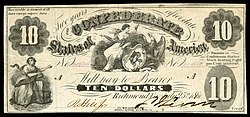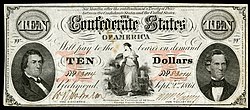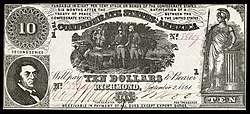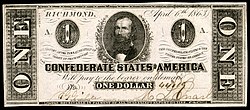| Series/Date | Type [n 4] | Value | Image | Comments [n 5] |
|---|
| 1First Series | T–1
5 Apr 1861
21 Jun 1861 | 1000$1,000 |  | John C. Calhoun, Andrew Jackson
National Bank Note Company
(607 issued) |
|---|
T–2
8 Apr 1861
23 Jul 1861 | 0500$500 |  | Ceres, The Crossing (by James Smillie)
National Bank Note Company
(607 issued) |
|---|
T–3
5 Apr 1861
21 Jun 1861 | 0100$100 |  | Minerva, railroad
National Bank Note Company
(1,606 issued) |
|---|
T–4
5 Apr 1861
21 Jun 1861 | 0050$50 |  | Slaves working in a field
National Bank Note Company
(1,606 issued) |
|---|
T–5
25 Aug 1861
23 Sep 1861 | 0100$100 |  | Justice, Hudson River Railroad, Minerva
Southern Bank Note Company
(5,798 issued) |
|---|
T–6
25 Aug 1861
23 Sep 1861 | 0050$50 |  | Justice, Agriculture and Industry, George Washington
Southern Bank Note Company
(5,798 issued) |
|---|
| 2Second Series | T–7
29 Jul 1861
22 Oct 1861 | 0100$100 |  | George Washington, Ceres, and Proserpina
Hoyer & Ludwig (Richmond, VA)
(37,155 issued) [n 6] |
|---|
T–8
29 Jul 1861
22 Oct 1861 | 0050$50 |  | Tellus, George Washington
Hoyer & Ludwig (Richmond, VA)
(123,564 issued) |
|---|
T–9
25 Jul 1861
26 Oct 1861 | 0020$20 |  | Sailing ship
Hoyer & Ludwig (Richmond, VA)
(264,988 issued) |
|---|
T–10
25 Jul 1861
2 Nov 1861 | 0010$10 |  | Liberty (seated), Liberty (leaning on shield)
Hoyer & Ludwig (Richmond, VA)
(170,994 issued) |
|---|
T–11
29 Jul 1861
7 Sep 1861 | 0005$5 |  | Sailor (leaning), Liberty (seated)
Hoyer & Ludwig (Richmond, VA)
(73,355 issued) |
|---|
| T–12 | 0005$5 |  | "Confederate States of America"
Jules Manouvrier (New Orleans, LA)
(15,556 issued) |
|---|
| 3Third Series | T–13
22 Oct 1861
16 Apr 1862 | 0100$100 |  | Sailor (standing), slaves loading cotton
Hoyer & Ludwig (Richmond, VA)
(629,284 issued) |
|---|
T–14
22 Oct 1861
16 Apr 1862 | 0050$50 |  | Sailors, Moneta with treasure chest
Hoyer & Ludwig (Richmond, VA)
(469,660 issued) |
|---|
T–15
8 Jan 1862
15 May 1862 | 0050$50 |  | Hope, Hudson River Railroad, Justice
Southern Bank Note Company
(14,860 issued) |
|---|
T–16
17 Apr 1862
10 Dec 1862 | 0050$50 |  | Jefferson Davis
Keatinge & Ball (Richmond, VA)
(425,944 issued) |
|---|
T–17
14 Sep 1861
5 Nov 1861 | 0020$20 |  | Liberty, Ceres between Commerce and Navigation
Hoyer & Ludwig (Richmond, VA)
(43,732 issued) |
|---|
T–18
24 Oct 1861
16 Aug 1862 | 0020$20 |  | Sailor, Sailing ship
Hoyer & Ludwig (Richmond, VA)
(2,366,486 issued) |
|---|
T–19
8 Jan 1862
15 May 1862 | 0020$20 |  | Minerva, Navigation, Blacksmith
Southern Bank Note Company
(14,860 issued) |
|---|
T–20
21 Jun 1862
8 Dec 1862 | 0020$20 |  | Alexander H. Stephens, Industry between Commerce and beehive
B. Duncan (Columbia, S.C.)
(2,834,251 issued) |
|---|
T–21
28 Jun 1862
15 Nov 1862 | 0020$20 |  | Alexander H. Stephens
Keatinge & Ball (Columbia, S.C.)
(164,248 issued) |
|---|
T–22
13 Nov 1861
15 May 1862 | 0010$10 |  | Thetis, Native Americans, Female with X
Southern Bank Note Company
(58,860 issued) |
|---|
T–23
15 Nov 1861
30 Dec 1861 | 0010$10 |  | John E. Ward, Wagon of cotton, Corn gatherer
Leggett, Keatinge & Ball (Richmond, VA)
(20,333 issued) |
|---|
T–24
20 Feb 1862
8 Dec 1862 | 0010$10 |  | Robert M.T. Hunter (left); Reverend Alfred L. Elwyn (vignette, as child)
Leggett, Keatinge & Ball (Richmond, VA)
(278,400 issued) |
|---|
T–25
12 May 1862
9 Aug 1862 | 0010$10 |  | Robert M.T. Hunter (left); Hope; C.G. Memminger
Keatinge & Ball (Richmond, VA)
(178,716 issued) |
|---|
T–26
12 Jul 1862
8 Dec 1862 | 0010$10 |  | Robert M.T. Hunter (left); Hope; C.G. Memminger
Keatinge & Ball (Richmond, VA)
(514,400 issued) |
|---|
T–27
26 Nov 1861
5 Dec 1861 | 0010$10 |  | Liberty; Train
Hoyer & Ludwig (Richmond, VA)
(8,576 issued) |
|---|
T–28
23 Jan 1862
13 Dec 1862 | 0010$10 |  | Ceres and Commerce; Train
Hoyer & Ludwig (Richmond, VA)
J.T. Patterson (Columbia, S.C.)
(1,074,980 issued) |
|---|
T–29
17 Mar 1862
13 Sep 1862 | 0010$10 |  | Slave picking cotton; canal
B. Duncan (Richmond, VA)
(286,627 issued) |
|---|
T–30
14 Jun 1862
3 Jan 1863 | 0010$10 |  | Robert M.T. Hunter (left); engraving of the painting General Marion Inviting a British Officer to Share His Meal by John Blake White; Minerva
B. Duncan (Columbia, S.C.)
(1,939,810 issued) |
|---|
T–31
13 Nov 1861
15 May 1862 | 0005$5 |  | Navigation; Commerce, Agriculture, Justice, Liberty, and Industry; George Washington statue
Southern Bank Note Company
(58,860 issued) |
|---|
T–32
15 Nov 1861
30 Dec 1861 | 0005$5 |  | Boy; Machinist with hammer
Leggett, Keatinge & Ball (Richmond, VA)
(20,333 issued) |
|---|
T–33
13 Mar 1862
19 Jun 1862 | 0005$5 |  | C.G. Memminger; Minerva
Leggett, Keatinge & Ball (Richmond, VA)
(136,736 issued) |
|---|
T–34
12 May 1862
8 Dec 1862 | 0005$5 |  | C.G. Memminger; Minerva
Keatinge & Ball (Richmond, VA)
(228,644 issued) |
|---|
T–35
26 Nov 1861
5 Dec 1861 | 0005$5 |  | Slaves load cotton; Indian princess
Hoyer & Ludwig (Richmond, VA)
(7,160 issued) |
|---|
T–36
31 Mar 1862
3 Jan 1863 | 0005$5 |  | Sailor; Commerce (seated)
Hoyer & Ludwig (Richmond, VA)
J.T. Patterson (Columbia, S.C.)
(3,694,890 issued) |
|---|
T–37
7 Apr 1862
13 Sep 1862 | 0005$5 |  | C.G. Memminger; Sailor (seated); Justice and Ceres
B. Duncan (Richmond, VA)
(1,002,478 issued) |
|---|
| 4Fourth Series | T–38 | 0002$2 |  | Judah P. Benjamin; The South striking down the Union
B. Duncan (Columbia, S.C.)
(~36,000 issued) |
|---|
| T–39 | 0100$100 |  | Milkmaid; train with straight steam
Hoyer & Ludwig (Richmond, VA)
J.T. Patterson (Columbia, S.C.)
(284,000 issued) |
|---|
| T–40 | 0100$100 |  | Milkmaid; train with diffused steam
J.T. Patterson & Co. (Columbia, S.C.)
(214,400 issued) |
|---|
| T–41 | 0100$100 |  | John C. Calhoun; Slaves working; Confederacy
Keatinge & Ball (Richmond, VA)
(670,400 issued) |
|---|
| T–42 | 0002$2 |  | Judah P. Benjamin; The South striking down the Union
B. Duncan (Columbia, S.C.)
(1,520,000 issued) |
|---|
| T–43 | 0002$2 |  | Judah P. Benjamin; The South striking down the Union
B. Duncan (Columbia, S.C.)
(194,900 issued) |
|---|
| T–44 | 0001$1 |  | Liberty; Steamship at sea; Lucy Pickens
B. Duncan (Columbia, S.C.)
(1,689,860 issued) |
|---|
| T–45 | 0001$1 |  | Liberty; Steamship at sea; Lucy Pickens
B. Duncan (Columbia, S.C.)
(412,500 issued) |
|---|
| T–46 | 0010$10 |  | Ceres; Robert M.T. Hunter
Hoyer & Ludwig (Richmond, VA)
(635,250 issued) |
|---|
| T–47 | 0020$20 |  | Ceres; Robert M.T. Hunter
Test pattern or fantasy note |
|---|
| T–48 | 0010$10 |  | Ceres; Robert M.T. Hunter
Test pattern or fantasy note |
|---|
| 5Fifth Series | T–49 | 0100$100 |  | Soldiers; Lucy Pickens; George W. Randolph
Keatinge & Ball (Richmond, VA)
(628,640 issued) |
|---|
| T–50 | 0050$50 |  | Jefferson Davis
Keatinge & Ball (Richmond, VA & Columbia, S.C.)
(414,200 issued) |
|---|
| T–51 | 0020$20 |  | Tennessee State Capitol; Alexander H. Stephens
Keatinge & Ball (Columbia, S.C.)
(776,800 issued) |
|---|
| T–52 | 0010$10 |  | Proposed state capitol (Columbia, S.C.); Robert M.T. Hunter
Keatinge & Ball (Columbia, S.C.)
(3,060,000 issued) |
|---|
| T–53 | 0005$5 |  | Virginia State Capitol; C.G. Memminger
Keatinge & Ball (Columbia, S.C.)
(2,833,600 issued) |
|---|
| T–54 | 0002$2 |  | Judah P. Benjamin
Keatinge & Ball (Columbia, S.C.)
(607,000 issued) |
|---|
| T–55 | 0001$1 |  | Clement Claiborne Clay
Keatinge & Ball (Columbia, S.C.)
(1,141,200 issued) |
|---|
| 6Sixth Series | T–56 | 0100$100 |  | Soldiers; Lucy Pickens; George W. Randolph
Keatinge & Ball (Columbia, S.C.)
(1,950,400) |
|---|
| T–57 | 0050$50 |  | Jefferson Davis
Keatinge & Ball (Richmond, VA and Columbia, S.C.)
(2,349,600 issued) |
|---|
| T–58 | 0020$20 |  | Tennessee State Capitol; Alexander H. Stephens
Keatinge & Ball (Columbia, S.C.)
(4,429,600 issued) |
|---|
| T–59 | 0010$10 |  | Proposed state capitol (Columbia, S.C.); Robert M.T. Hunter
Keatinge & Ball (Columbia, S.C.)
(7,420,800 issued) |
|---|
| T–60 | 0005$5 |  | Virginia State Capitol; C.G. Memminger
Keatinge & Ball (Columbia, S.C.)
(7,745,600 issued) |
|---|
| T–61 | 0002$2 |  | Judah P. Benjamin
Keatinge & Ball (Columbia, S.C.)
(689,200 issued) |
|---|
| T–62 | 0001$1 |  | Clement Claiborne Clay
Keatinge & Ball (Columbia, S.C.)
(1,645,600 issued) |
|---|
| T–63 | 0000.50$0.50 |  | Jefferson Davis
Archer & Daly (Richmond, VA)
(1,831,517 issued) |
|---|
| 7Seventh Series | T–64 | 0500$500 |  | Confederate seal and second national flag; Stonewall Jackson
Keatinge & Ball (Columbia, S.C.)
(~154,000 issued) |
|---|
| T–65 | 0100$100 |  | Soldiers; Lucy Pickens; George W. Randolph
Keatinge & Ball (Columbia, S.C.)
(~964,000 issued) |
|---|
| T–66 | 0050$50 |  | Jefferson Davis
Keatinge & Ball (Columbia, S.C.)
(1,671,444 issued) |
|---|
| T–67 | 0020$20 |  | Tennessee State Capitol; Alexander H. Stephens
Keatinge & Ball (Columbia, S.C.)
(~4,150,000 issued) |
|---|
| T–68 | 0010$10 |  | Horses pulling cannon; Robert M.T. Hunter
Keatinge & Ball (Columbia, S.C.)
(~9,071,000 issued) |
|---|
| T–69 | 0005$5 |  | Virginia State Capitol; C.G. Memminger
Keatinge & Ball (Columbia, S.C.)
(~5,526,100 issued) |
|---|
| T–70 | 0002$2 |  | Judah P. Benjamin
Keatinge & Ball (Columbia, S.C.)
(~944,000 issued) |
|---|
| T–71 | 0001$1 |  | Clement Claiborne Clay
Keatinge & Ball (Columbia, S.C.)
(~681,500 issued) |
|---|
| T–72 | 0000.50$0.50 |  | Jefferson Davis
Archer & Halpin (Richmond, VA)
(~1,100,000 issued) |
|---|












































































